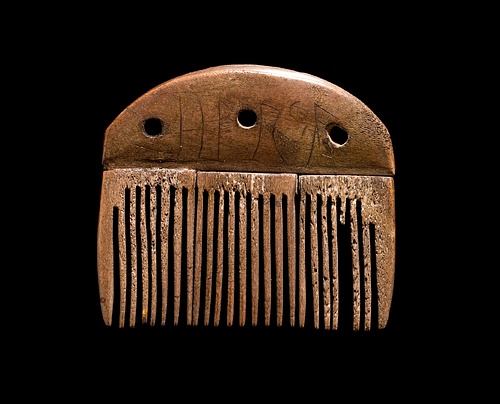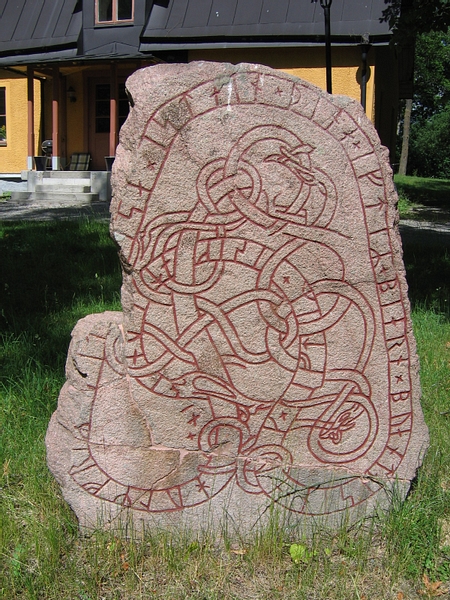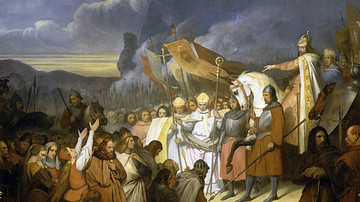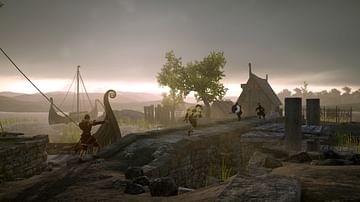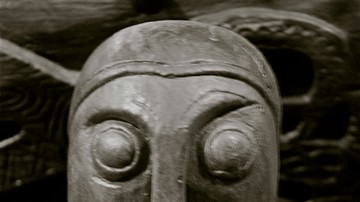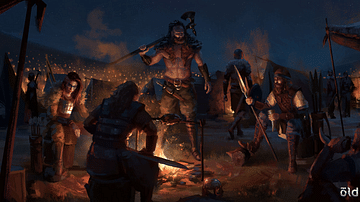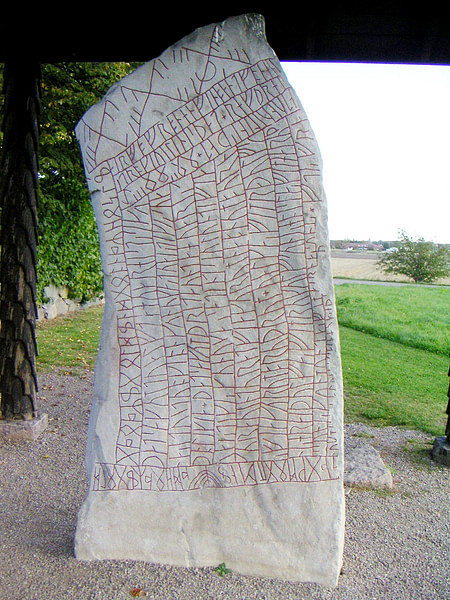
Runes are letters in the runic alphabets of Germanic-speaking peoples, written and read most prominently from at least c. 160 CE onwards in Scandinavia in the Elder Futhark script (until c. 700 CE) and the Younger Futhark - which illuminated the Viking Age (c. 790-1100 CE) - as well as in England and Frisia in the Anglo-Saxon Futhorc (also known as Anglo-Frisian Futhorc) writing system. In England, runes were in use from the 5th century CE until perhaps the turn of the 11th century CE, while in Scandinavia the use of runes extended well into the Middle Ages and beyond.
Designed to be inscribed first into wood and metal, during the Viking Age large amounts of inscribed runestones were erected predominantly throughout Scandinavia; these runestones, despite being tough to decipher, are of absolutely critical value to us, as they are the only written source contemporary to this period. Germanic Runes are found in areas with a history of Germanic-speaking peoples, from Iceland to Scandinavia, through England, through Central Europe to Constantinople – basically places Germanic tribes on occasion called home plus any place the Vikings touched.
How Runes Are Read
Runes are generally made up of vertical lines – one or more – with 'branches' or 'twigs' jutting out diagonally (and very occasionally horizontally) upwards, downwards or in a curve from them. They can be written both from left to right and from right to left, with asymmetrical characters being flipped depending on the direction of writing. Each rune, of which major and minor versions existed, represents a phoneme (speech sound) and had a name, made up of a noun, that started (and in one case, ended) with the sound the rune was mainly associated with. Lots of regional and temporal variation existed in the shapes of the letters.
Origins & Development
The origins of the runic script are shrouded in a decent amount of mystery. The earliest inscription that is without a doubt runic is the one reading harja (possibly meaning “comb”, or “warrior”) on the Vimose comb from Denmark, dated to c. 160 CE, which uses runes so confidently and maturely that scholars feel it must result from at least a hundred years' experience in writing in runes. How exactly this tradition was pulled out of the hat, however, is subject to much debate and speculation. Inspiration from both the Greek and Roman alphabets, as well as a northern Italic or even Danish origin, has been suggested. The Greek route is perhaps the most likely in light of the resemblances in script, and a variation of a Greek alphabet – Greek was unstandardised between c. 700-400 BCE – may have reached Germanic speakers by way of a 'middle-man' group perhaps made up of eastern Europeans. Norse mythology itself offers us a fun alternative, too, in depicting the god Odin gaining the knowledge of the runes after sacrificing himself to himself and hanging on the “windy tree” for nine nights with no food or drink (Hávamál, 139-140).
Either way, by 500 CE use of the runic script had fanned out across the Germanic world – from Norway, Sweden, Denmark and England to outposts in Germany, Russia, Poland and Hungary – and recorded a variety of Germanic languages. The main runic scripts that eventually came into being were:
- Elder Futhark (at least c. 160-700 CE)
- Younger Futhark (c. 700 - c. 1200 CE)
- Anglo-Saxon Futhorc (also Anglo-Frisian Futhorc, c. 5th century - c. 1000 CE)
- Medieval Futhork (fully formed c. 13th century CE).
Right from the earliest runic remains we have found, variation is present, which ties in with the fact that the runic alphabet is obviously not one-on-one with a language, but was used in various contexts to write a multitude of Germanic languages spoken across a large geographic area. Shapes of runes may vary, as may order, usage, medium, and layout, resulting from, for example, regional, social or chronological differences. There is thus no such thing as a standardised runic alphabet. Variation had skyrocketed by 700 CE, around which time a divergence can be seen from the previously fairly uniform Elder Futhark to the reduced-character Younger Futhark in Scandinavia which would later crystallise into Medieval Futhork, and the more elaborate Anglo-Saxon Futhorc across Britain and Frisia.
Elder Futhark
Elder Futhark (also Elder Fuþark – þ being the 'th' sound in English 'thin' – or older Fuþark/Futhark) is the earliest classified runic script and was used until c. 700 CE in the Germanic world. Counting 24 characters and being surprisingly uniform, it is named after the first six characters in the alphabet (f-u- þ (th)-a-r-k). The runes are grouped together in three rows of eight, each group being called an ætt (pl. ættir), and each rune was named after things that start (or in one case, end) with that sound. Although preserved manuscripts from the 9th and 10th centuries CE have given us the names of the Younger Futhark and Anglo-Saxon runes, no such luxury is awarded us for Elder Futhark. However, based mostly on the Younger Futhark names supplemented with Anglo-Saxon and even Gothic, the Elder Futhark rune-names have been reconstructed to the best of our modern-day ability.
Elder Futhark was used to write Proto-Germanic, Proto-Norse, Proto-English, and Proto-High German – thus, geographically quite widely spread – and survives today in just under 400 inscriptions (found so far), most of which show substantial wear and tear and are only partly readable. It is likely this number only represents a fraction of the real total; the rest must be lost in time and space. They are initially found on wood – which of course does a poor job at standing the test of time – and metal in the form of names. Popular surfaces were military equipment, coins, and jewellery such as bracteates, brooches or combs, and the typically Scandinavian runestones, some of which were in Elder Futhark as opposed to the much more frequently represented later Younger Futhark. Although Scandinavia, northern Germany and eastern Europe were the earliest homes to such items, after c. 400 CE England, the Netherlands, and southern Germany joined the club. Because they focus mostly on ownership and show no visible connection to society at any greater level, runic writing in societies up to c. 700 CE is assumed to not to have had a central function.
Despite Elder Futhark's largely uniform nature, variation existed too, though, and it is important to realise the rune-row generally presented for the Elder Futhark today is only a main line. Here follows the most commonly given Elder Futhark rune-row, starting with the rune, its transliteration, its inferred (Proto-Germanic) name and the meaning of that name:
- ᚦ þ ('th') *þurisaz “giant”
- ᚨ a *ansuz “one of the Æsir (gods)”
- ᚱ r *raiðō “ride”/”journey”
- ᚲ k *kaunan “boil”/”blister” (or maybe “torch”)
- ᚷ g *gebō “gift”
- ᚹ w *wunjō “joy”
- ᚺ h *hagalaz “hail” (the precipitation)
- ᚾ n *nauðiz “need”/“emergency”/”desperation”
- ᛁ I *īsaz “ice”
- ᛃ j *jēra “year”, but typically “harvest”/”good harvest”
- ᛈ p *perðō? “pear tree”? (unclear)
- ᛇ ï/æ? *eihaz/ei(h)waz “yew tree” (but very confusing attestation)
- ᛉ z *algiz? “elk“
- ᛊ s *sōwilō “sun”
- ᛏ t *tīwaz/*teiwaz “Týr” (the god)
- ᛒ b *berkanan “birch”
- ᛖ e *ehwaz “horse”
- ᛗ m *mannaz “man”
- ᛚ l *laguz “lake” (or maybe “leek”)
- ᛜ ŋ ('ng') *ingwaz “Ing” (/Yngvi, another name of the god Freyr)
- ᛞ d *dagaz “day”
- ᛟ o *ōþala/*ōþila “inherited property”/”possession”
Younger Futhark
After c. 700 CE, in Scandinavia, Elder Futhark was adapted into the Younger Futhark (or Younger Fuþark) script used for writing Old Norse, the language of the Viking Age. Eight of the original 24 characters were ditched and many others were simplified or changed shape, as well as more variety cropping up in general. Vitally, it is the medium of our only written (Scandinavian) Viking Age sources. The runes that were dropped are ᚷ, ᚹ, ᛇ, ᛈ, ᛖ, ᛜ, ᛟ, and ᛞ - transliterated as g, w, ï/æ, p, e, ŋ, and d. The ættir, or runic groups, known from Elder Futhark, remained in place, now becoming groups of six, six, and four, respectively. In Younger Futhark, runes had more than one possible sound attached to them, specifically no longer making clear in writing the distinction between voiced and unvoiced consonants such as k and g, which were both written with the rune ᚴ. Vowels, too, learned to share, their value having to be gleaned from the context they were found in. This makes this runic script quite difficult to read (for us, today, at least).
It seems this new script was adopted in a lightning-quick fashion, perhaps due to a deliberate effort, but probably at least influenced by changes in the language or in sounds. Michael Barnes tells us how,
…by the beginning of the eight century all, or virtually all, rune-carvers were using the same sixteen runes – a remarkable example of unity in the apparent absence of a central authority to promote it. But that was as far as the unity went. When it came to the realisation of many of the sixteen runes, a much more open policy prevailed. Some carvers experimented with runic form, simplifying many characters. Others resisted change, or were unaware of it. Different traditions developed. (63)
In Denmark, for instance, a “long-branch” version of the runic script was preferred, whereas Norway and Sweden stuck to “short-twig”, and the Hälsingland area in Sweden even developed a set of runes – Hälsinge/staveless runes - missing the main staves (except in the i-rune) in a zealous simplification. The rune-row given for Younger Futhark below, then, is a composite showing the most common forms across the board; the row starts with the rune, then its transliteration, its (Old Norse) name and the meaning of that name:
- ᚠ f/v fé “wealth”/“cattle”
- ᚢ u/w, y, o, ø úr “slag from iron production”/”rain(storm)”
- ᚦ ᚦ, ð ('th') ᚦurs ('thurs') “giant”
- ᚬ o, æ áss/óss “Æsir”/”estuary”
- ᚱ r reið “ride”/(“vehicle”)
- ᚴ k, g kaun “ulcer”/”boil”
- ᚼ h hagall “hail”
- ᚾ n nauðr “need”/”threat”/”emergency”
- ᛁ I, e ísa/íss “ice”
- ᛅ a, æ ár “year”, typically “good year”/”good harvest”
- ᛋ s sól “sun”
- ᛏ t, d Týr “Týr” (the god), also used for any god
- ᛒ b, p björk/bjarkan/bjarken “birch”
- ᛘ m maðr “man”/”person”
- ᛚ l lǫgr (lögr) “lake” or a small body or water
- ᛦ r yr “yew”, yew tree, or maybe “elm”
Younger Futhark headlines in the big bang in runic inscriptions: the number of known inscriptions hugely increases for Viking Age Scandinavia after 700 CE, with runes found on often-decorated runestones large and small which dot the landscape. These stones helped bump up the numbers to a total of almost 3000 Scandinavian runic inscriptions during this period - in stark contrast with the barely 400 Elder Futhark ones. All mediums taken together, the inscriptions tell us about ownership or inheritance, politics (power struggles, raiding and conquests, or major invasions), religion (including Christianity and its spread), travel (inland but also abroad), and literature and myth.
The runestones, specifically, usually serve the purpose of commemorating and celebrating the dead, and mainly stuck to a similar formula running along the lines of like “X (and Y) raised this stone in memory of Z, their relative” (Viking World, 283), sometimes adding an obituary, prayer or signature, or stating the deceased was a good warrior, farmer or husband, or indicating status, too. A good mainstream example would be the Helland 3 inscription from Rogaland in south-western Norway, tentatively dated to the early 11th century CE, which is transcribed as:
þurmurþr:risti:stin:þãnã|aft:þrunt:sunsin
Þormóðr raised this stone after Þróndr, his son (Barnes, 71).
However, deciphering runestones was not straightforward, as words were not always separated (by otherwise present points or double points between letters) runes were sometimes left out altogether.
Viking Age runestones and runestone-fragments are unevenly spread across Scandinavia and appear in a variety of sources. They appear around inhabited parts of Norway (c. 60 of them); in hotspots in northeast Jutland in Denmark as well as on Bornholm and in southern Skåne (c. 220); and in Sweden (c. 2600 stones) mainly focused in the provinces around Lake Mälaren, with Östergötland, Västergötland, Småland, Öland and Gotland also adding up to about a 100 stones. Outside of Scandinavia, around 50 runestones can be found (including fragments). Dating runestones can be difficult especially when based on the language alone, but a method using the types of ornamentation, developed in 2003 CE by Anne-Sofie Gräslund, is proving useful.
The stones also raise the question of literacy: as Michael Barnes explains,
…we have no idea how many Viking-Age Scandinavians were literate in runes, but there must have been a critical mass that made it meaningful to have commemorative inscriptions carved in stone and set up in public places. (88)
Some are even signed by their carver(s) (for whom it must have been a specific skill); the three most famous and most-attested ones we know of today being Asmund, Fot, and Öpir. Although its commissioners were mainly male and the stones mostly male-oriented, Anne-Sofie Gräslund explains that "a closer look at all inscription material from Uppland reveals that women are mentioned fairly often in the texts, either as the raisers or the ones commemorated, either alone or together with men"(Vikings. The North Atlantic Saga, 68).

Anglo-Saxon Futhorc
Unlike Younger Futhark's reduction in characters from Elder Futhark, in Britain and Frisia (in what is now the Netherlands), things went in the opposite direction. Arguably beginning as early as the 5th century CE, runes were actually added – between four and eight – in this script known as Anglo-Saxon Futhorc (or Fuþorc, synonymous with Anglo-Frisian Fuþorc). Anglo-Saxons and Frisians agreed to disagree on some finer points of usage, though, and earlier and later Anglo-Saxon runic use also varied.
The runes were used to write Old English and Old Frisian, with Frisian not using the final two runes of the rune-row added for the Old English usage. Fewer than 200 inscriptions – mainly on personal items, weapons, stone crosses, and coins – are known. From the 7th century through the 9th century CE, medieval runes pop up as coin legends, hinting at a practical application of the script. In England, Christianity entered the stage in the 7th century CE and proceeded to leave its mark on Futhorc, too, innovating and standardising away (mainly visible in the runes ᚣ and ᛠ used for /y/ and /æe/) likely in a conscious reform. Except in manuscripts, Latin was used side by side with runes. The Anglo-Saxon runes held strong until at least the end of the 10th century CE, after which their use seems to grind to a halt. A composite rune-row showing common versions of the Anglo-Saxon Futhorc can be given as follows, starting with the rune, its transliteration, its name in Old English, and the meaning of that name:
- ᚠ f feoh “wealth”
- ᚢ u ūr “aurochs”
- ᚦ þ, ð (th-sound) þorn “thorn”
- ᚩ o ōs “one of the gods”, also “mouth”
- ᚱ r rād “ride”
- ᚳ c cēn “torch”
- ᚷ g gyfu “gift”
- ᚹ p, w pynn “mirth”
- ᚻ h hægl “hail” (the precipitation)
- ᚾ n nȳd “need”
- ᛁ I īs “ice”
- ᛄ j gēr “year”, typically “harvest”
- ᛇ eo/ɨ ēoh “yew”
- ᛈ p peorð unknown, but maybe “pear tree”
- ᛉ x eolh “elk sedge”
- ᛋ s sigel “sun”
- ᛏ t Tīƿ “glory”
- ᛒ b beorc “birch”
- ᛖ e eh “horse”
- ᛗ m mann “man”
- ᛚ l lagu “lake”
- ᛝ ŋ (ng-sound) Ing the hero “Ing”
- ᛟ œ ēðel “inherited estate”
- ᛞ d dæg “day”
- ᚪ a āc “oak”
- ᚫ æ æsc “ash” (the tree)
- ᚣ y ȳr “bow”
- ᛡ ia, io/y īor “eel”
- ᛠ ea ēar “grave”
Medieval Futhork
In Scandinavia, between the late 10th century CE and c. 1200 CE, Younger Futhark was gradually adapted into the Medieval Futhork (or Medieval Fuþork), which by the 13th century CE had taken on a fairly consistent form. Mainly sticking to the 16 Younger Futhark runes, some extra bits and bobs were added to the runes themselves – in particular in the shape of dots that set apart a specific sound value from the other sounds the undotted rune could represent. A dotted rune was not counted as a new rune but as a part of their undotted partners-in-crime. The ð-sound (modern English "th" in "weather"), for example, is not listed in the rune-row below, as it is the dotted version (ᚧ) of the ᚦ rune (which stands for þ ("th" in English "thin").
Finally, too, as a step away from the confusing world of Younger Futhark, Medieval Futhorc had by the 13th century CE begun to double some consonant runes instead of leaving doubles out. Bind-runes (ligatures of two or more runes) also jump up in popularity, probably under the influence of Latin, which liked writing stuff like "æ" and "œ" and which tagged along on the wings of Christianity which converted Scandinavia around 1000 CE. The order of the runes in the list had one change, from m-l to l-m. Runes stuck around, now with a companion Roman alphabet, throughout the Middle Ages, and were used in such things as personal letters, merchants' labels, amulets, and manuscripts (sometimes mixed with Latin). A common Medieval Futhork rune-row can be given as follows, indicating the rune and its transliteration:
- ᚠ f
- ᚢ u
- ᚦ þ ('th')
- ᚮ o
- ᚱ r
- ᚴ k
- ᚼ h
- ᚿ n
- ᛁ i
- ᛆ a
- ᛌ, ᛋ s
- ᛐ t
- ᛒ b
- ᛘ m
- ᛚ l
- ᛦ (ᚤ, ᛨ) i
- ᛂ e
- ᛅ, ᛆ æ
- ᚯ ø
- ᚵ g
- ᛑ d
- ᛔ (ᛕ) p
- ᛋ z, c
Other
Keeping the runic flame alight after the medieval period, medieval runes actually remained in use, increasingly heavily influenced by Latin, in Sweden's Dalarna province from the 16th through to the 20th century CE, its particular forms known as Dalecarlian runes or Dalrunes. We can conclude that runes are tenacious, for sure; the use of modern runes has even made it into modern paganism, and they appear widely in a fantasy context. My favourite is the runic alphabets' inspiration of (among others) the dwarven script known as Cirth as developed by J.R.R. Tolkien in his The Lord of the Rings universe.

